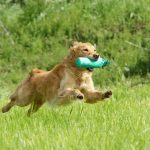by Ryan Eder
As I waited in the holding blind to run my trusted hunting partner in his second HRC Finished test, I realized that it’s all too easy to overlook marking concepts that are relevant to hunting situations.
We spend time at the retriever club training grounds working on technical concepts in the water such as re-entries or down the shore, but birds at 25 yards didn’t occur to me. Naturally, the hunt test was three marks, all less than 35 yards away, splashing into the decoy spread and weeds. As my dog overran the first mark, I quickly thought to myself, We need to do more of these in training!
In the field, we do not have the manicured grounds that clubs or pro trainers have. We are hunting fields, marshes, lakes, ponds, and potholes that pose several challenging factors that affect our dog’s ability to mark. Consequently, I can speak for myself and say that I need to do a better job of identifying factors that increase the difficulty of marking fallen birds for our retrievers in hunting situations.
Following are some factors and marks every duck hunter should consider working on in their duck season prep for their hunting dog. In some, we’ll veer a bit from the “do-it-yourself” aspect of the column and employ a helper.
Birds in Cover
Have you ever thrown your dog a mark that lands in front of a bush, hay bale, or tuft of cover in a relatively open field? Even if your dog focuses on the mark, he often times will drive to the fall area and hunt around the obstruction before realizing the bird is there. Why? Many times a dog will not want to run straight at a large obstruction in his path to a bird without deviating his line, or he’ll put on a small hunt first. In the marsh or field, it’s a common occurrence for a bird to land in the cattails or thick bunches of cover or treeline. Try to simulate falls like this in your marking training to ensure confidence in your dog’s ability to mark and hunt fall areas.
Long Entries and Exits in Water
This is quite common on small bodies of water, such as prairie potholes. A duck is hit over water but your blind is 50 yards away. The dog has to cover that distance before he even hits the water. To a dog that doesn’t see this concept in training, he’ll run toward the mark , but when he reaches the shore of the pothole, that waterline may as well be a brick wall.
Long water entries need to be worked on in training, and it is simply a matter of running water marks several yards away from the shoreline. For dogs new to this concept, throw a white bumper that is visible to the dog once he reaches the water to give him a high chance of success of punching through” the water after a long entry on land.
Similarly, there are several situations in which a duck comes down well beyond the water you are hunting. The dog has to cross the water and keep going on land, and it’s not as simple as it sounds. We often train our dogs with marks that land on the shoreline or near it. A dog may swim across a body of water, but he expects a bird to be there relatively close. As a result, a bird shot 50-plus yards beyond the body of water poses a challenging mark.
Try to run marks in a pond where you can have the bird or bumper fall a substantial distance beyond the shoreline (30-50 yards minimum). At first, you may need to throw a “helper bird” to get the dog to drive beyond the shore and get to the fall. This means that once the dog is on his way to the mark, as he nears the far shore, have a bird thrower say, “Hup,” or, “Hey,” and throw another bird or bumper that the dog can see. The dog should continue to drive past the water and get to the mark successfully. Try to repeat the mark without help to achieve success.
Out to Sea
There are times when a water mark demands that our dog swim quite a distance before he reaches the bird. Contrary to what some dog handlers think, this is a very difficult concept for a dog with minimal experience. Swimming “out to sea” requires tremendous confidence and perseverance from your dog. Imagine winging a bird that sails an extra 75 yards out into the lake and is being blown farther out by wind and waves, or a situation where several ducks are shot over the spread in a river with some current. By the time the dog retrieves some of the birds, another couple have drifted downstream requiring a much longer swim.
To train for this, our dogs need to see marks that require longer swims to successfully complete the retrieve. Begin this as a single retrieve — if your dog is successful regularly, you can work on doubles or triples where the memory birds (not the last bird thrown) are the “out to sea” marks. This requires great memory, confidence, and perseverance.
The hunting season presents factors and situations that are not always accounted for in our offseason training. Ideally, we as dog handlers and hunters should prepare for these concepts prior to the season versus realizing holes in our training programs in the field (or in my case in the holding blind at a test). Incorporating these types of marks will pay off in the blind when your dog can fall back on his experience in training and have success on some tough marking situations in the field. And this season, keep track of those situations in which your dog has trouble, and design marks to mimic them. Best of luck to you all this season!






